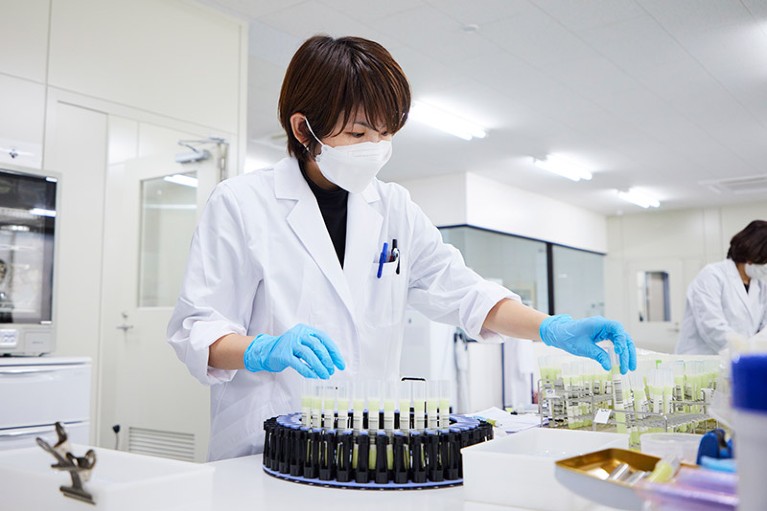A government report suggests that Japanese researchers are not producing as much world-class research as other countries such as the United States or China.Credit: Makiko Tanigawa/Getty
Japan’s contribution to world-class research continues to decline, despite having one of the world’s largest research communities, according to a report by the Japanese Ministry of Education, Culture, Sports, Science and Technology (MEXT), released in English on 25 October.
Masatsura Igami, the director of the Center for S&T Foresight and Indicators at the National Institute of Science and Technology Policy (NISTEP) in Tokyo, and one of the authors of the 2023 edition of the Japanese Science and Technology Indicators report, says that the findings highlight several areas that Japan could explore to improve its global standing. “Japan’s current research environment is far from ideal and is unsustainable. The research environment must shape up,” he says.
The report shows that Japan ranks third globally in the total number of researchers, following China and the United States. However, this workforce is not producing the same level of high-impact research as it was two decades ago. Japan’s global share of research papers in the top 10% of most-cited articles has slipped from 6% to 2%, intensifying concerns in Japan about its dwindling international standing.
Source: MEXT
Igami explains that the rest of the world has overtaken Japan in terms of quality research output. “Japanese researchers haven’t become less productive. But the research environment in other countries has improved so much over the past few decades,” he says.
Time and money
Some of the decline might be attributable to funding, Igami says. The 2023 report shows that research spending in the university sector has grown by roughly 80% in the United States and Germany, 40% in France, quadrupled in South Korea and increased by more than tenfold in China over the past two decades. By contrast, Japan’s spending has increased by 10%.

Nature Index 2023 Japan
However, even if researchers receive more funding, producing high-impact research might still be challenging, because Japanese scientists have less time for actual research, Igami says. According to a 2020 analysis by MEXT, the proportion of time that university researchers dedicated to science decreased from 47% to 33% between 2002 and 2018.
“University researchers are increasingly expected to take on diverse roles in teaching, industry collaborations and community engagement. In medicine, junior researchers are dedicating more time to clinical duties to maintain hospital revenue,” says Igami. “While there are benefits to universities contributing to the wider society in diverse ways, it limits the time available for research.”
The report’s findings confirm those of a previous survey of early-career researchers that pointed to a lack of time for research as a notable factor in job dissatisfaction. Haruka Ono, a civil engineer at the Toyohashi University of Technology in Japan, who was part of the group that conducted the survey, says that respondents found administrative tasks too onerous.
“Anything from visa paperwork for foreign lab members, to taking calls from landlords claiming that your students aren’t paying rent on time — that’s your responsibility if you are a principal investigator,” she says.
Source: MEXT
Transforming the research environment
To secure more dedicated research time, Wataru Iwasaki, a computational biologist at the University of Tokyo, who represents early-career researchers in the Science Council of Japan, would like to see extra support staff, including administrative staff and laboratory technicians as well as staff with business expertise to facilitate collaborations with the private sector. Currently, Japanese universities have one technician per 20 researchers, a figure markedly lower than other countries in the 2023 report.
Support staff would also increase trend of moving away from the hierarchical laboratory models prevalent in Japan, adds Ono. Traditional lab structures give senior faculty members control over research direction and resources, with junior faculty often playing an assisting part. For example, Tohoku University, which has been selected as the recipient of Japan’s new university endowment fund, has pledged to appoint more junior researchers as principal investigators. But without support staff, the sudden autonomy may end up counterproductive for junior researchers. Ono says when she was made a principal investigator, she went from no experience in running a lab, to having students depend on her for direction while also needing to meet her own research goals, without any professional support — an experience she describes as “overwhelming”. “The anxiety that came with it was not constructive for attempting long-term, high-impact research,” she says.
Igami says that seeing lab members struggle with increased seniority might be putting off younger scientists from pursuing a career in research. He says that the number of PhD students has dropped by 21% in the past two decades. Attracting more PhD students to the lab, who have more research experience than undergraduates and master’s students, will be crucial for facilitating higher-impact research for Japan, he says.
“Japan’s research environment hasn’t progressed from the past, and career prospects in academia are only getting worse, as universities increasingly offer temporary positions for researchers,” he says.
